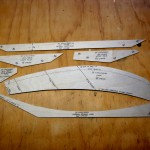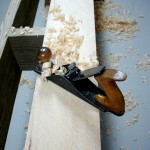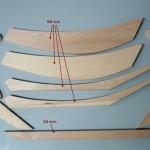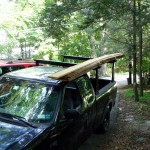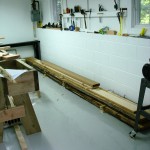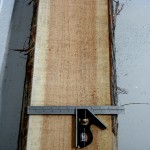“Jointing” is preparing a flat surface over a long area, usually in preparation for joining two boards together.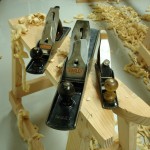 The Stanley number 7 “jointer” plane has a very long body and nearly 8 pounds of heft. Here again, there are electric tools for such work. As with planers, they embody rapidly rotating knives that pulverize wood into very fine dust. My “new” Stanley number 7, makes long thin shavings instead. It’s length is key to how it works. It is shown here with two other planes to give a size comparison. Left to right, the planes are: number 5 jack plane, number 7 jointer plane, and number 40 scrub plane.
The Stanley number 7 “jointer” plane has a very long body and nearly 8 pounds of heft. Here again, there are electric tools for such work. As with planers, they embody rapidly rotating knives that pulverize wood into very fine dust. My “new” Stanley number 7, makes long thin shavings instead. It’s length is key to how it works. It is shown here with two other planes to give a size comparison. Left to right, the planes are: number 5 jack plane, number 7 jointer plane, and number 40 scrub plane.
This one came from Jon Zimmer, a tool trader in Portland Oregon. Jon is one of the few who specialize in old tools and has a grading system that identifies the quality of the tools he sells. He is accurate, easy to deal with and has a great reputation. His tools are exactly as he describes them. A few other folks who also have great reputations are Patrick Leach, Sandy Moss, and Bob Kaune. All of these people know the tools, have accurate grading systems and can be trusted. While one might find occasional lower prices on eBay, the quality there varies and many of the people selling old tools are not experts like the folks just mentioned. On eBay “buyer beware.”
This plane dates to between 1933 and 1941. It has seen a lot of good use, but no visible abuse. It did have a goodly collection of wood dust in the corners and crevices. Basic cleaning took about an hour. Another hour of sharpening brought the iron to perfection.
My use for this plane is for jointing edges. It’s a really good thing to have certain parts of a boat fit together very well. For example, the bottom of the Fiddlehead is three long boards joined edge to edge. All that holds them together is glue … and a good fit. There are no other fasteners holding those boards together.
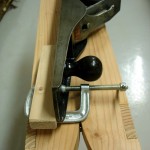
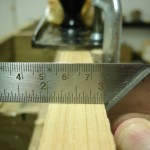 Of course, making square edges is usually desireable. So, how does one do that when running a hand plane along the edge of a board? With a fence. And there are fences for these planes, but they are rare and expensive. I have devised an alternative, based on a method we used at the Wooden Boat School. Clamp a block of wood (squared of course) to the nose of the plane and use it as a fence. Steady as you go and it works very well.
Of course, making square edges is usually desireable. So, how does one do that when running a hand plane along the edge of a board? With a fence. And there are fences for these planes, but they are rare and expensive. I have devised an alternative, based on a method we used at the Wooden Boat School. Clamp a block of wood (squared of course) to the nose of the plane and use it as a fence. Steady as you go and it works very well.
